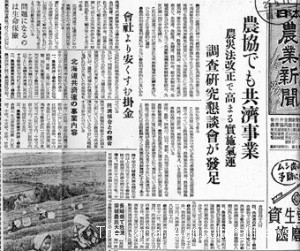Defined in the provisions of nokyo law

Article of Nihon nogyoshimbun (The Japan Agricultural News) reporting the story about the prospect of starting of kyosai (mutual insurance) business by nogyokyodokumiai (agricultural cooperatives, or “nokyo”)
After the negotiation over one year and eight months between Ministry of Agriculture and Forestry and the Allied Forces General Headquarters (GHQ), nogyokyodokumiai (agricultural cooperatives, or “nokyo”) law was promulgated in November 1947 and came into effect on 15 December. In Article 10, Paragraph (1), Item8 of nokyo law, there was the provisions of “facility regarding kyosai (mutual insurance) for agricultural disaster or other disasters.” This provision became the starting point of nokyo-kyosai (agricultural cooperatives mutual insurance) business.
GHQ issued “Farmers release command” (memorandum of understanding regarding agrarian reform) on 9 December 1945. Part of the Japanese side’s answer against “Farmers release command” became the first draft regarding kyosai (mutual insurance) by the Japanese government (Ministry of Agriculture and Forestry). The first draft of nokyo bill included only summarized main points of the bill, which did not take the form of the bill, included no paragraph of “kyosai (mutual insurance).” The second draft of nokyo bill, that was not taking the form of the bill, also included no paragraph of “kyosai (mutual insurance).” However, the draft of nokyo bill in the law provisions form included the paragraph of “facility regarding kyosai (mutual insurance) for agricultural disaster.”
The second draft and the third draft of nokyo bill supposed kyosai (mutual insurance) business run by the prefectural federation of nokyo (agricultural cooperatives). Until this third draft of nokyo bill, the Ministry of Agriculture and Forestry had imaged nokyo (agricultural cooperatives) as the public entity similar to war time nogyokai (agricultural institution). From this point of view, the ministry created the provisions of “facility regarding kyosai (mutual insurance) for agricultural disaster.” The ministry had imagined nokyo (agricultural cooperatives) to run also the compulsory kyosai (mutual insurance) for agricultural disaster based on nogyo-hoken (agricultural insurance) law.
However, while the establishment of “nogyo-saigai-hosho (agricultural disaster compensation) law (successor of nogyo-hoken (agricultural insurance) law)” was promoted in parallel, the fourth draft and the fifth draft of nokyo bill changed the expression of the paragraph into “kyosai (mutual insurance) for agricultural disaster or other disasters,” in order to suggest voluntary participation.
At the last stage, the seventh draft and the eighth draft of nokyo bill changed the expression of the paragraph into “facility regarding kyosai (mutual insurance) for agricultural disaster or other disasters.” The final draft of nokyo bill was submitted to the National Parliament and nokyo law was established.
How the Ministry of Agriculture and Forestry was trying to do operate by nokyo law? “Commentary of nokyo law”, edited by Agricultural Division of the Ministry of Agriculture and Forestry, which is said to be written by Takekazu Ogura (1910 – 2002), later vice minister of the Ministry of Agriculture and Forestry, mentioned the outline as follows;
“Nokyo can carry out the business regarding kyosai (mutual insurance) for agricultural disaster or other disasters. However, nogyo-saigai-hosho (agricultural disaster compensation) law is to be newly established instead of the livestock law and nogyo-hoken (agricultural insurance) law. Therefore, nokyo based on free establishment and voluntary participation can’t carry out compulsory kyosai (mutual insurance) business. What nokyo can do is disaster kyosai (mutual insurance) for the cooperatives members and their family, or disaster kyosai (mutual insurance) for the equipment such as machine, house, and factory etc. ”
Initially, regarding nokyo law, the Ministry of Agriculture and Forestry intended to provide the paragraph of “kyosai (mutual insurance)” combined with voluntary kyosai (mutual insurance) and compulsory insurance system. GHQ denied this utterly, because GHQ had the policy that new nokyo should be established as liberal cooperatives. For this reason, “compulsory insurance and voluntary insurance” was clearly divided. “Public insurance and private insurance” was also clearly divided. It was decided that nogyo-kyosai-kumiai (agricultural insurance associations, or agricultural mutual relief associations) should carry out public compulsory insurance, and nokyo (agricultural cooperatives) should carry out private voluntary insurance.
However, even after the establishment of nogyo-saigai-hosho (agricultural disaster compensation) law, nogyo-kyosai (agricultural insurance) organization continued to demand carrying out of voluntary kyosai (mutual insurance) business against GHQ. GHQ had formally said “voluntary kyosai (mutual insurance) business shall be run by nokyo,” but it is said that GHQ had suggested that “both organizations can carry out voluntary kyosai (mutual insurance).” Based on this suggestion, both organizations competed to promote voluntary kyosai (mutual insurance) business in the rural areas.
As a result of strong petition of nogyo-kyosai (agricultural insurance) organization against GHQ, GHQ stated “There is no change in policy that voluntary kyosai (mutual insurance) business should be carried out by nokyo, but the National Parliament can decide its handling.” The 5th National Parliament passed the lawmakers’ amendment law. By the law, some kyosai (mutual insurance) business for some equipment such as building was allowed to be regarded as the voluntary kyosai (mutual insurance) business.
Reference = National Mutual Insurance Federation of Agricultural Cooperatives ed. “Evolution History of Agricultural Cooperatives Mutual Insurance” the Federation, Institute of cooperative management “History of Nogyokyodokumiai (agricultural cooperatives) system Volume 2″ the Institute, Noriaki Niwata & Hitoshi Hirata “History and Reality of Cooperatives insurance” Cooperatives insurance Study Group

